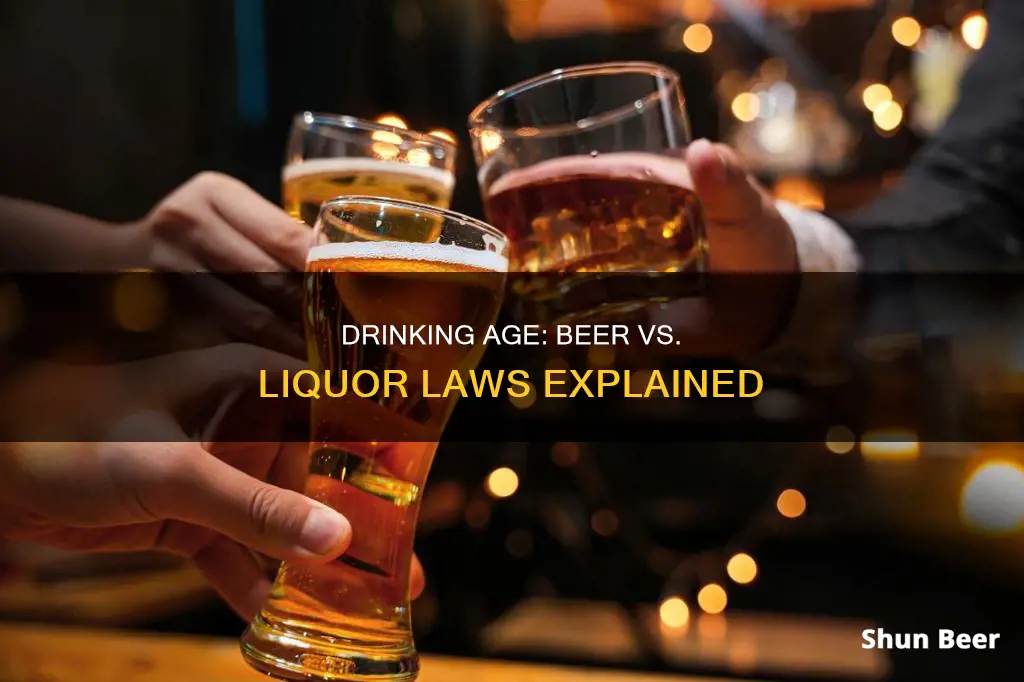
Alcohol laws vary across the world, with some countries setting a minimum legal drinking age of 18, while others like the United States have a minimum legal purchasing age of 21. Interestingly, the drinking age hasn't always been the same, and in the US, it used to differ by state before the National Minimum Drinking Age Act of 1984. This act was implemented to reduce drunk driving rates among teenagers and young adults, and any state that doesn't follow it can lose up to 10% of its federal highway funding.
In the US, the minimum drinking age of 21 applies to both beer and liquor, but in other countries, the legal drinking age can vary depending on the type of alcoholic beverage. For instance, in India, the legal drinking age for wine and beer is 21, while for hard liquor, it's 25.
What You'll Learn

Drinking age laws in the USA
History of Drinking Age Laws
The history of drinking age laws in the USA has changed over time. Before the 20th century, there were no drinking age restrictions in colonial America, and alcohol consumption by young teenagers was common. After the ratification of the 21st Amendment in 1933, which ended Prohibition, most states set the minimum legal drinking and purchasing age to 21, as it was the voting age at the time.
National Minimum Drinking Age Act
In 1984, the National Minimum Drinking Age Act was passed, establishing 21 as the national minimum legal drinking age. This law was phased in over a few years, and by 1988, all 50 states had raised their minimum legal drinking age to 21. The Act was passed to reduce drunk driving fatalities and underage drinking. States that do not comply with this law can lose up to 10% of federal funding for highway projects.
State Exceptions to the National MLDA
While the national minimum legal drinking age is 21, there are state exceptions where drinking below this age is permitted in specific circumstances. These exceptions include:
- Religious activities: In some states, it is allowed for minors to consume small amounts of alcohol as part of religious services or ceremonies.
- Educational purposes: In some states, minors are permitted to consume alcohol for educational purposes, such as in cooking schools or culinary classes.
- Lawful employment: Minors working in the restaurant or food and beverage industry may be allowed to purchase alcohol for work purposes but are usually not permitted to consume it.
- Parental, guardian, or spousal consent: Some states allow minors to consume alcohol with the permission of a parent, guardian, or spouse in private residences or on private property. Other states specify that the family member must be present while the alcohol is consumed.
- Law enforcement purposes: In some states, it is legal for underage individuals employed in law enforcement to purchase and consume alcohol as part of undercover work or investigations.
- Medical reasons: Some states permit minors to consume alcohol for medical reasons if prescribed or administered by a licensed physician.
Blood Alcohol Concentration (BAC) Laws
In addition to drinking age laws, each state has its own laws regarding the blood alcohol concentration (BAC) levels that define intoxication. These laws vary, and the legal BAC limit can depend on age, with stricter limits for those under 21.
Drinking Age Laws by State
While the national minimum legal drinking age is 21, each state has its own specific laws and exceptions. For example:
- Wisconsin allows underage drinking in bars or restaurants with a parent present.
- California permits underage drinking in the presence of a responsible adult.
- Illinois has strict laws against possession or consumption of alcohol by minors, except when at home with a parent or legal guardian.
In conclusion, drinking age laws in the USA are complex and vary by state and situation. While the national minimum legal drinking age is 21, there are exceptions in many states that permit drinking below this age in specific circumstances. These laws are constantly evolving, and it is essential to stay informed about the drinking age regulations in your specific state.
Is Expired Beer Safe to Drink?
You may want to see also

Drinking age laws in India
India's drinking age laws vary significantly from state to state. Alcohol consumption is prohibited in some states, such as Bihar, Gujarat, Nagaland, and Mizoram, as well as the union territory of Lakshadweep. Other states, like Kerala, have a monopoly on liquor sales, prohibiting private retailers and making the state government the sole retailer of alcohol.
In states where alcohol is permitted, the legal drinking age ranges from 18 to 25. For example, in Goa, Himachal Pradesh, Puducherry, Rajasthan, Sikkim, and the Andaman and Nicobar Islands, the legal drinking age is 18. In most Indian states, the legal drinking age is 21, including in Delhi, the nation's capital. Notably, Kerala has increased the legal drinking age to 23 as part of a plan to phase out alcohol sales and consumption. The highest legal drinking age in India is 25, observed in Maharashtra, Chandigarh, Meghalaya, and Punjab, with strict rules in place to discourage underage drinking.
The variation in drinking age laws across India is due to the subject of alcohol being governed independently by each state. The Constitution of India's State List (Schedule VII) includes 'alcohol for human consumption', empowering state legislatures to create their own rules around alcohol sales and consumption.
Beer Drinking at Target Field: Family Section Rules
You may want to see also

Drinking age exceptions in the USA
In the United States, the minimum legal drinking age is 21. However, there are some exceptions to this rule in certain states. With the exception of five states (Alabama, Arkansas, Idaho, New Hampshire, and West Virginia), all states and Washington, D.C., allow underage consumption of alcohol under limited circumstances.
For example, in many states, it is legal for those under 21 to drink with parental supervision on private property. Additionally, some states permit underage drinking for religious or medical purposes. Some states also offer prosecutorial exemptions for underage persons reporting an assault or medical emergency.
The specific exceptions vary by state, and it's important to note that local county and city ordinances may further restrict underage drinking. Here are some examples of exceptions to the minimum legal drinking age in different states:
- In Illinois, the legal purchase age is 19 for beer and wine, and 21 for liquor.
- In Maryland, North Carolina, South Carolina, Virginia, and Washington, D.C., the legal purchase age is 18 for beer and wine, and 21 for liquor.
- In Kansas, Ohio, Oklahoma, and South Dakota, the legal purchase age is 18 for 3.2% ABV beer, and 21 for stronger beer, wine, and liquor.
- In some states, like Oregon, there is no minimum age for drinking in private residences as long as it's not in a licensed establishment.
- In states like New York and Wisconsin, underage drinking is permitted for religious purposes.
- In states such as California and Florida, underage drinking is allowed for medical purposes with a prescription.
Beer and Braces: Ceramic Care and Drinking
You may want to see also

Drinking age exceptions in India
The drinking age and the laws regulating the sale and consumption of alcohol vary significantly across India. In some states, the consumption of alcohol is prohibited, while in others, the legal drinking age falls anywhere between 18 and 25.
In the states of Bihar, Gujarat, Nagaland, and Mizoram, as well as the union territory of Lakshadweep, the consumption of alcohol is banned. In some districts of Manipur, there is a partial ban on alcohol. All other Indian states permit alcohol consumption but set different legal drinking ages.
In Maharashtra, the legal drinking age for wine and beer is 21, while for other liquors, it is 25. However, in three districts—Wardha, Gadchiroli, and Chandrapur—the consumption and sale of alcohol are entirely prohibited.
In Karnataka, the legal drinking age is 21, but the law is ambiguous. While the Karnataka Excise Act, 1965, sets the minimum age to purchase alcohol at 18, many bars serve those above 18, and a few bars refuse to serve anyone below 21.
In Uttar Pradesh, the legal drinking age was initially 18 but was raised to 21 through an amendment in 1976.
Additionally, some states have specific laws regarding the sale of alcohol. For example, in Kerala and Tamil Nadu, private parties are prohibited from owning liquor stores, making the state government the sole retailer of alcohol. In some states, liquor may be sold at groceries, departmental stores, banquet halls, or farmhouses. Certain tourist areas also have special laws permitting alcohol sales on beaches and houseboats.
Beer as a Diuretic: Should You Drink It?
You may want to see also

History of drinking age laws in the USA
The history of drinking age laws in the USA has been a tumultuous one, with the minimum legal drinking age (MLDA) changing several times over the years. Here is a detailed overview of the key moments in the history of drinking age laws in the country:
Pre-Prohibition Era (Before 1920)
In the pre-Prohibition era, there was no national drinking age in the United States. Prior to the enactment of the 18th Amendment in 1920, which ushered in Prohibition, the drinking age varied from state to state, with most states not enforcing a drinking age at all. During this period, it was common for young teenagers to consume alcohol, even in taverns. However, with the growing influence of the temperance movement and increasing medical understanding of the dangers of alcohol, attitudes towards drinking began to shift.
Prohibition (1920-1933)
In 1920, the 18th Amendment to the U.S. Constitution was ratified, ushering in the era of Prohibition. This amendment made it illegal to manufacture, transport, or sell intoxicating liquors nationwide. This marked a significant shift in the country's attitude towards alcohol, with the consumption of alcoholic beverages becoming prohibited.
Post-Prohibition Era (1933-1960s)
Prohibition came to an end in 1933 with the ratification of the 21st Amendment, which repealed the 18th Amendment. Most states set their drinking age to 21, as this was the voting age at the time. However, some states chose to set their drinking age lower. This period saw a relaxation of alcohol restrictions, but the minimum drinking age remained a state-level decision.
1960s and 1970s
During the late 1960s and 1970s, there was a push to lower the drinking age across the country. This was largely due to the passing of the 26th Amendment, which lowered the voting age from 21 to 18. As a result, between 1969 and 1976, approximately 30 states lowered their minimum purchase age, mostly to 18. This change was also influenced by the Vietnam War, where young men who were ineligible to drink or vote were being conscripted to fight. The slogan "old enough to fight, old enough to vote" gained traction during this period.
1980s and the National Minimum Drinking Age Act
The push to lower the drinking age led to a significant increase in alcohol-related issues, particularly drunk driving fatalities. In response, several states voluntarily raised their purchase ages back to 19, 20, or 21. Then, in 1984, Congress passed the National Minimum Drinking Age Act, which standardized the drinking age across the country. This act required states to set their minimum purchase and public possession age to 21 or lose 10% of their federal highway funds. By mid-1988, all 50 states, along with the District of Columbia, had raised their purchase age to 21, though some territories like Puerto Rico, Guam, and the Virgin Islands maintained a lower drinking age.
Present Day
Today, the minimum legal drinking age in the United States remains at 21, with only a few exceptions in certain territories. While there have been debates and efforts to lower the drinking age, the current law still stands. The National Minimum Drinking Age Act has been upheld as constitutional and is supported by various organizations, including Mothers Against Drunk Driving and the American Medical Association. However, there are also groups that advocate for a lower drinking age, arguing that it denies young adults the opportunity to learn responsible drinking habits.
Drinking Beer with a Yeast Infection: Is It Safe?
You may want to see also
Frequently asked questions
The minimum legal drinking age in the United States is 21 years.
The minimum drinking age varies by country. While most countries have a minimum legal drinking age of 18, some have a minimum legal drinking age of 19 or 20. A few countries, like Libya, Somalia, and Sudan, prohibit the sale, production, and consumption of alcohol entirely.
No, the drinking age has changed over time. Before the National Minimum Drinking Age Act of 1984, the drinking age varied by state.
Yes, in 45 states, there are exceptions that allow people under 21 to drink alcohol in certain situations. For example, in 29 states, someone under 21 may drink with their parent's permission if they are in a private residence or on private property.
No, the minimum drinking age of 21 applies to all alcoholic beverages, including beer and liquor. However, states may have different laws regarding the purchase and consumption of beer and liquor, with some states allowing the sale of beer to those under 21 if it has an alcohol content below a certain threshold.







